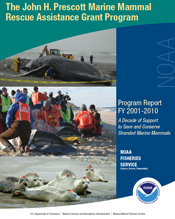Marine Mammal Health and Stranding Response Program (MMHSRP)
Hot Topics
- 45 Eligible Proposals Received for the FY2016 Prescott Grant
- UME Declared for Guadalupe Fur Seals in California
- FY2015 Prescott Grants Awarded for Marine Mammal Rescue Assistance
- UME Declared for Large Whales in the Gulf of Alaska
- Results from Barataria Bay Dolphin Health Study
- UME Declared for Bottlenose Dolphins in the Mid-Atlantic
- 2013 California Sea Lion UME Declared
- Ongoing 2010 Northern Gulf of Mexico Cetacean Unusual Mortality Event
» Archive

Dolphin health assessment in Louisiana
Credit: NOAA

Prescott Grant report [pdf]
After the Deep Horizon Oil Spill

Dr. Brian Stacy, NOAA veterinarian, cleans a young Kemp's ridley turtle
Photo: NOAA/FWCC
This program was formalized by the 1992 Amendments to the Marine Mammal Protection Act, and NOAA's National Marine Fisheries Service (NMFS) was designated as the lead agency to coordinate related activities. The program has the following components:
- stranding networks
- responses/investigations of mortality events
- biomonitoring
- tissue/serum banking
- analytical quality assurance
For more information, see our:
Stranding Networks
To respond to marine mammal strandings, volunteer stranding networks were established in all coastal states and are authorized through Letters of Authority from the NMFS regional offices. Through a National Coordinator and regional coordinators, NMFS oversees, coordinates, and authorizes these activities and provides training to personnel.
Marine Mammal Stranding Report: Level A [pdf] [78 KB] (OMB form used by stranding networks in the collection of marine mammal stranding data)
- Marine Mammal Stranding Networks
- NMFS Regional Marine Mammal Stranding Coordinators
- Sea Turtle Stranding and Salvage Network (STSSN)
Biomonitoring
In recent years, high concentrations of potentially toxic substances in marine mammals and an increase in new diseases have been documented, and scientists have begun to consider the possibility of a link between these toxic substances and marine mammal mortality events.
These studies contribute to a growing, worldwide effort of marine mammal biomonitoring, not only to help assess the health and contaminant loads of marine mammals, but also to assist in determining anthropogenic impacts on marine mammals, marine food chains, and marine ecosystem health.
NMFS provides participants in the program with training and some financial support. Using strandings, and bycatch animals, the participants provide tissue/ serum archiving, samples for analyses, disease monitoring and reporting, and additional response during disease investigations.
The Analytical Quality Assurance(AQA)
The AQA aspect of the MMHSRP was designed to ensure accuracy, precision, level of detection, and intercomparability of data in the chemical analyses of marine mammal tissue samples. The AQA consists of annual interlaboratory comparisons and the development of control materials and standard reference materials for marine mammal tissues. The new NIST Charleston facility is taking the lead for this activity.
Unusual Mortality Events
In response to the 1987-88 dolphin die-off, NMFS established a Working Group on Marine Mammal Unusual Mortality Events to create criteria for determining when an unusual mortality event is occurring and to direct responses to such events.
The Working Group is periodically called upon to lend its expertise in situations where circumstances indicate an unusual mortality event may be occurring and may provide guidance throughout the event. This Group meets annually. Through consultation with other government agencies, the Working Group has been able to build on its existing knowledge of mortality events to better respond to marine mammal unusual mortality event.
National Marine Mammal Tissue Bank
The National Marine Mammal Tissue Bank was formally established in 1992 and provides protocols and techniques for the long-term storage of tissues from marine mammals for retrospective contaminant analyses. The Tissue Bank is located at the Ft Johnson NOAA facility in Charleston, SC.
The Tissue Bank uses the biomonitoring sites noted above and other trained personnel to collect tissues on:
- specific indicator species (Atlantic bottlenose dolphins, Atlantic white-sided dolphins, pilot whales, harbor porpoise)
- mass stranding animals
- mortality events
Last Updated: November 2016


